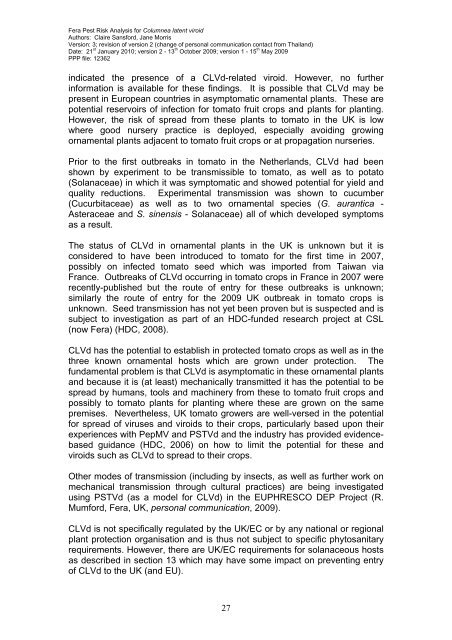Columnea latent viroid - The Food and Environment Research ...
Columnea latent viroid - The Food and Environment Research ...
Columnea latent viroid - The Food and Environment Research ...
Create successful ePaper yourself
Turn your PDF publications into a flip-book with our unique Google optimized e-Paper software.
Fera Pest Risk Analysis for <strong>Columnea</strong> <strong>latent</strong> <strong>viroid</strong><br />
Authors: Claire Sansford, Jane Morris<br />
Version: 3; revision of version 2 (change of personal communication contact from Thail<strong>and</strong>)<br />
Date: 21 st January 2010; version 2 - 13 th October 2009; version 1 - 15 th May 2009<br />
PPP file: 12362<br />
indicated the presence of a CLVd-related <strong>viroid</strong>. However, no further<br />
information is available for these findings. It is possible that CLVd may be<br />
present in European countries in asymptomatic ornamental plants. <strong>The</strong>se are<br />
potential reservoirs of infection for tomato fruit crops <strong>and</strong> plants for planting.<br />
However, the risk of spread from these plants to tomato in the UK is low<br />
where good nursery practice is deployed, especially avoiding growing<br />
ornamental plants adjacent to tomato fruit crops or at propagation nurseries.<br />
Prior to the first outbreaks in tomato in the Netherl<strong>and</strong>s, CLVd had been<br />
shown by experiment to be transmissible to tomato, as well as to potato<br />
(Solanaceae) in which it was symptomatic <strong>and</strong> showed potential for yield <strong>and</strong><br />
quality reductions. Experimental transmission was shown to cucumber<br />
(Cucurbitaceae) as well as to two ornamental species (G. aurantica -<br />
Asteraceae <strong>and</strong> S. sinensis - Solanaceae) all of which developed symptoms<br />
as a result.<br />
<strong>The</strong> status of CLVd in ornamental plants in the UK is unknown but it is<br />
considered to have been introduced to tomato for the first time in 2007,<br />
possibly on infected tomato seed which was imported from Taiwan via<br />
France. Outbreaks of CLVd occurring in tomato crops in France in 2007 were<br />
recently-published but the route of entry for these outbreaks is unknown;<br />
similarly the route of entry for the 2009 UK outbreak in tomato crops is<br />
unknown. Seed transmission has not yet been proven but is suspected <strong>and</strong> is<br />
subject to investigation as part of an HDC-funded research project at CSL<br />
(now Fera) (HDC, 2008).<br />
CLVd has the potential to establish in protected tomato crops as well as in the<br />
three known ornamental hosts which are grown under protection. <strong>The</strong><br />
fundamental problem is that CLVd is asymptomatic in these ornamental plants<br />
<strong>and</strong> because it is (at least) mechanically transmitted it has the potential to be<br />
spread by humans, tools <strong>and</strong> machinery from these to tomato fruit crops <strong>and</strong><br />
possibly to tomato plants for planting where these are grown on the same<br />
premises. Nevertheless, UK tomato growers are well-versed in the potential<br />
for spread of viruses <strong>and</strong> <strong>viroid</strong>s to their crops, particularly based upon their<br />
experiences with PepMV <strong>and</strong> PSTVd <strong>and</strong> the industry has provided evidencebased<br />
guidance (HDC, 2006) on how to limit the potential for these <strong>and</strong><br />
<strong>viroid</strong>s such as CLVd to spread to their crops.<br />
Other modes of transmission (including by insects, as well as further work on<br />
mechanical transmission through cultural practices) are being investigated<br />
using PSTVd (as a model for CLVd) in the EUPHRESCO DEP Project (R.<br />
Mumford, Fera, UK, personal communication, 2009).<br />
CLVd is not specifically regulated by the UK/EC or by any national or regional<br />
plant protection organisation <strong>and</strong> is thus not subject to specific phytosanitary<br />
requirements. However, there are UK/EC requirements for solanaceous hosts<br />
as described in section 13 which may have some impact on preventing entry<br />
of CLVd to the UK (<strong>and</strong> EU).<br />
27
















